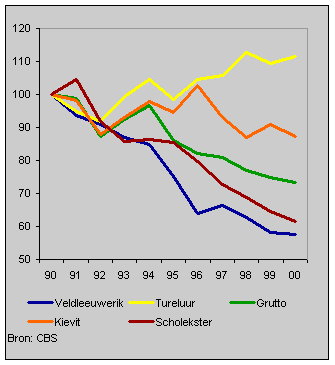Fewer meadow birds

According to figures from the national meadow bird counting grid populations of a number of common meadow birds in the Netherlands declined considerably between 1990 and 2000. In 2000, national populations of the black-tailed godwit, oystercatcher, lapwing and skylark were some 15 to 40 percent below the levels of 1990.
Meadow birds (1990=100)

Decline continues
The more than 25 percent decline in the number of black-tailed godwits is significant in an international respect, as more than half of the breeding population of this species live in the Netherlands.
For many species of meadow bird the decline set in earlier in the last century, as a consequence of more intensive farming methods. In the nineties in particular therefore, extensive measures were taken to protect meadow birds, such as nest protection, changed mowing procedures and setting aside reservation areas. In spite of these measures, however, the decline in meadow bird populations seems to be continuing. The only exception is the redshank: the number of redshanks has increased by about 10 percent in the last ten years.
Remarkable regional differences
The counting grid reveals remarkable regional differences. Numbers of black-tailed godwit, lapwing and redshank are not declining in the west and southwest of the country; their numbers are stable or have even risen slightly. It is the differences between the fen areas, of the Netherlands, were the traditional bastion of meadow birds, that are so surprising. In the peat areas of North and South Holland black-tailed godwit and lapwings have become more slightly more numerous, and the redshank has even increased substantially, while in the fen areas in the North of the Netherlands the decline in populations of the four species of waders is the strongest of all the regions. In 2000 the number of black-tailed godwit, lapwing and oystercatcher were on average half the numbers counted in 1990.
Leo Soldaat